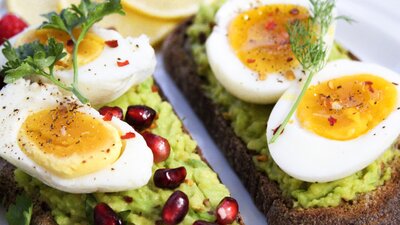Fats help absorb vitamins and minerals. While their tasks in every body remain the same, their presence differs between men and women. Women naturally hold more fat mass than men, so they rely more on these fats (lipids) for energy. It makes sense for women to eat more fats to support their energy levels. Healthy fats play a pivotal role in women by regulating hormones and exercise endurance.
Lipids & Hormones
It’s important to consider the menstrual cycle in women’s nutrition. The menstrual cycle involves peaks and dips of hormones between a 21-35 day period. This cycle can also cause a cycle of nutrients.
Fats can help support menstrual cycles. The presence of certain hormones such as estrogen and progestogen can prominently affect women’s nutrient requirements.
The early days of the follicular phase lowers estrogen and muscle glycogen levels, resulting in an increased carb intake. Then, the follicle grows and releases estrogen, stimulating its first peak in the cycle. This peak will occur during the final few days of the follicular phase. A high intake of carbohydrates can be more helpful for the follicular phase leading up to the hormonal peak (ovulation). However, an overconsumption of carbohydrates too soon could lead to heightened inflammation and reduced muscle glycogen utilization (1). Conversely, estrogen can also increase fat oxidation and decrease carbohydrate dependence. Therefore, a lower carbohydrate intake could be considered for daily use (2).
Women need more protein in the luteal phase to support the increase of protein oxidation (2). After ovulation, the body needs these nutrients to recover from ovulation. In the luteal phase, progesterone upregulation calls for more protein and overall energy. Since women are fat-adapted, the overall energy intake can be beneficial through fats. While there is an upcoming second peak in estrogen, progestogens are naturally higher in the luteal phase. This should also be considered for active women, who should adjust their protein intake accordingly.
Post-menopausal women experience an increase in fat mass and a decrease in lean mass. The Mediterranean Diet can improve lean body mass and cholesterol levels. A high-fat, low-carb diet is not recommended as a fat reduction approach. An alternative path would be a low-GI diet consisting of fibrous foods (3).
Exercising & Women
Menstrual cycles affect performance in women. Keeping in mind that women rely more on fats for energy, they can become fat-adapted during exercise. This causes women to metabolize more fat than men, even with the same exercise intensity. This also makes them less susceptible to fatigue (given where they are in their cycle). Women could last longer than men in endurance performances simply because of natural physiology. Endurance has varied between women in either phase. What matters is that women still have a higher endurance than men (2).
The time of their cycle also changes how they should recover from performance through nutrition. When planning out strength and endurance training, women should schedule around their cycle in order to prevent injury. They may be more prone to inflammation after ovulation. Progestogen has foiling actions to estrogen, classifying it as a catabolic hormone. This can make women more prone to injury during their luteal phase (2).
Best Healthy Fats
The menstrual cycle affects strength, metabolism, body temperature, fluid balance, and risk of injury. These can all be mediated through nutrition. Women should consider adding these healthy fat sources to their diet.
Omega-3’s contain anti-inflammatory properties that aid in recovery. These can be especially helpful in the follicular phase in which inflammation is elevated. These can be found in fatty fish and seeds (1).
Oils are the best quality sources of pure fats. Extra virgin olive oil is high in polyunsaturated fats and antioxidants. Coconut oil, while high in saturated fat, contains many antioxidant and anti-inflammatory qualities.
Soy is high in polyunsaturated fats, fiber, and protein. Soy can extend the length of the menstrual cycle and lower the risk of estrogen-based diseases (4).
Saturated fats should be limited for their disadvantages to gut health. Foods such as full-fat dairy, fatty red meat, and butter fall into this category.
In Summary
Healthy fats are a great addition to any diet. When it comes to women, they may be even more important. Make sure you consume these fats from healthy sources, train hard, and train smart.
Works Cited

